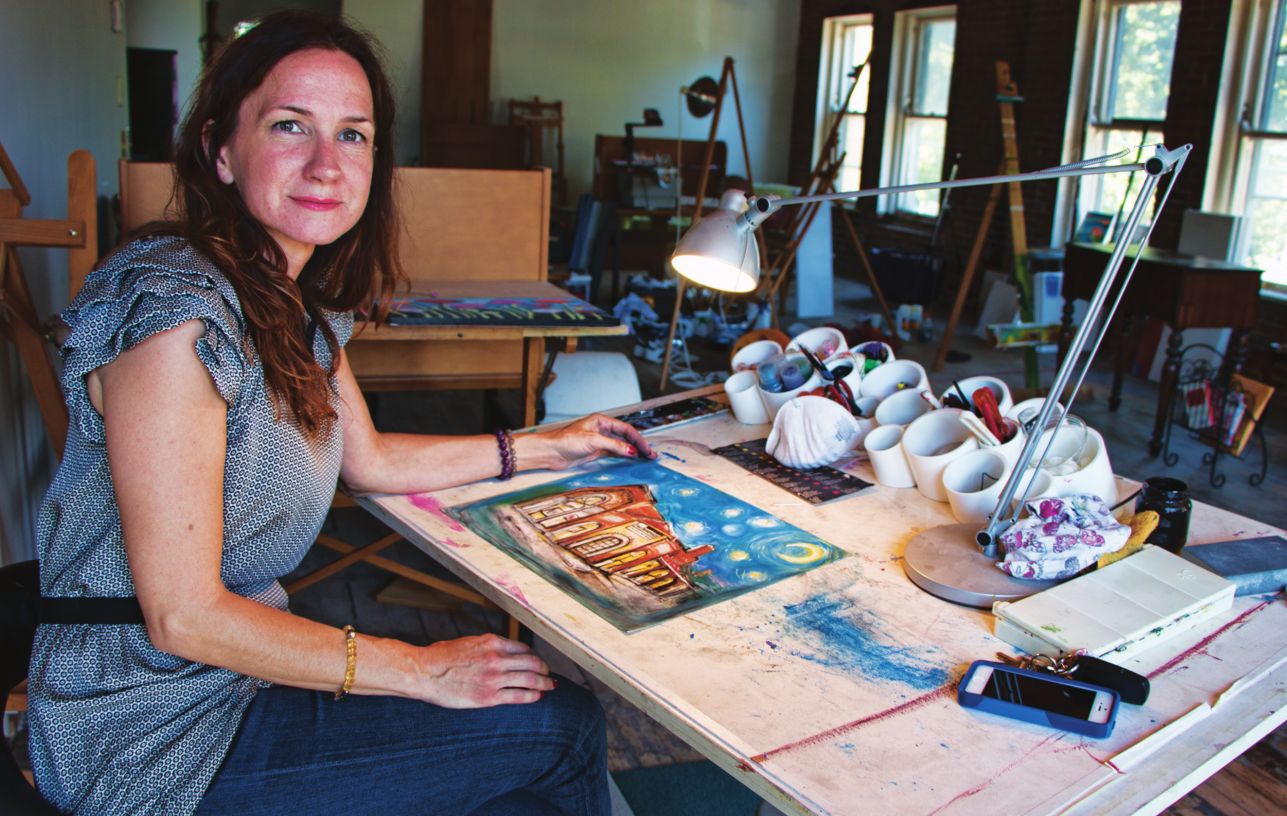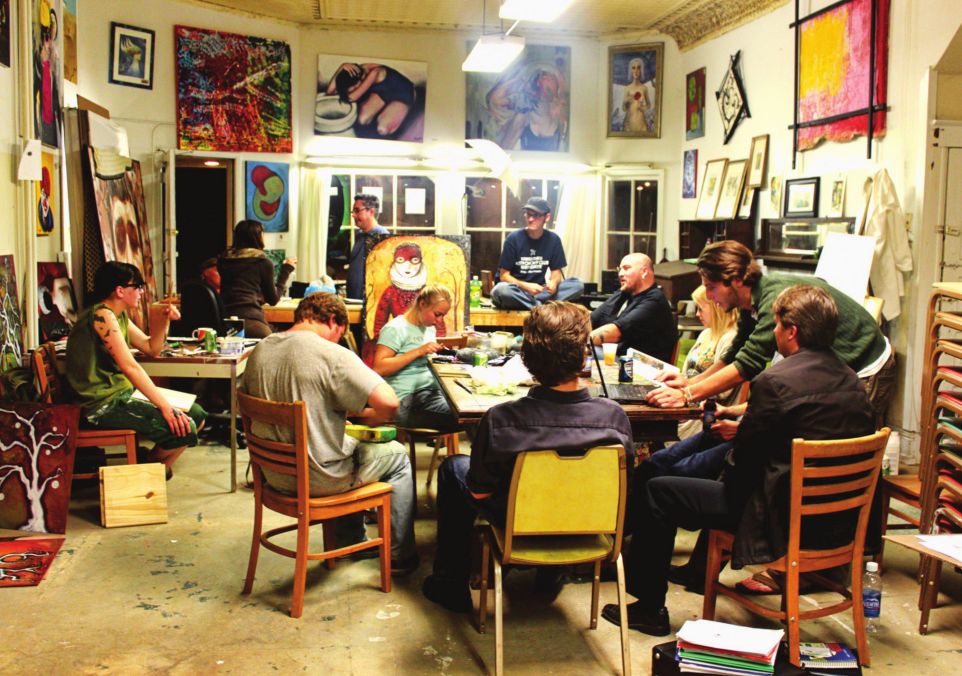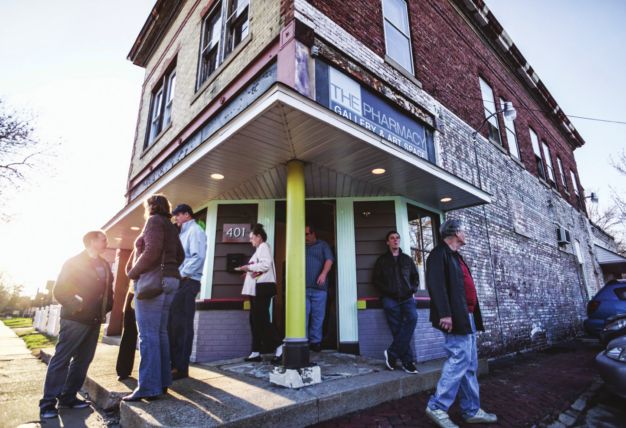
Artists on the move
With new digs and respect, The Pharmacy grows up
ARTS | Scott Faingold
Since its first group exhibit in November of 2011, the independent artist collective known as The Pharmacy has been a force to be reckoned with in the Springfield arts scene, providing affordable studio and gallery space for painters, sculptors and other artists as well as multiple well-attended exhibitions annually. In just under three years, a scrappy but ambitious group of upstarts has transformed into a streamlined arts organization without losing touch with its grassroots origins. The Pharmacy is now poised to take its place at the forefront of the city’s creative community with a move from its digs at 401 South Grand Avenue West (former home of King Harvest Food Co-Op and titular inspiration Watt Bros Pharmacy) into the former Widow at Windsor Antiques building at 711 South Fifth Street.
“I’ve mentioned this move to a couple people and they’ve said, ‘Wow, you guys are goin’ big time,” says Pharmacy member Janet Kueber Sgro.
“This isn’t big time, come on,” scoffs fellow member James Elliott. “Big time is being part of a group show in Chicago or New York. This is basically just a move up the street.”
“One of my favorite places to go was the Widow at Windsor,” says Pharmacy member Michelle Pacione. “I kept being drawn to that building.” After the Widow’s recent relocation to 625 E. Monroe, Pacione continued to be attracted to the site, a beautiful and sui generis structure that over the years has acted as a livery and a Cadillac dealership. Pacione was haunted by the notion that this would make an ideal space for The Pharmacy, extremely well-suited for both work and display space. After a few phone calls it was discovered that not only was the building available but the rent was not significantly higher than the South Grand location. “I felt like doing cartwheels,” says Pacione. “I was really excited to tell the group about it.” One unanimous vote later and the die was cast. The group will begin the process of relocating after finishing its 10th group exhibition this Saturday, Sept. 13.
There are several reasons for the group’s excitement at the move. The building promises greater visibility and accessibility (“On South Grand it feels like we’re kind of hidden – sometimes even we drive right past it,” says Sgro), and after relocating, The Pharmacy will be open to the public for regular hours for the first time. The physical traits of the building also promise far greater convenience, allowing member artists much freer passage between studio and gallery than is afforded on South Grand.
Although the group has no official pecking order, many of the organizational duties have fallen to Sgro, who has become a reluctant de facto figurehead for the group. “I think a lot of the reason that The Pharmacy has sustained itself is because Janet came on,” says Pacione. “The only role she ever wanted was just to help. She’s one of those leaders who absolutely doesn’t want to be a leader but in a good way because everybody trusts her judgment and knows that she’s gonna support us.”
The
Pharmacy has an impressive track record for a grassroots art project in
Springfield, Illinois, many of which start strong and eventually peter
out. Each of the nine previous group exhibits, from November 2011
through June of this year, has drawn large, enthusiastic crowds from all
walks of life and economic strata, with the 10th set for this Saturday
(see box, p. 14). “We get the skater kids and the suit and tie crowd,”
beams member artist Wendy Allen. The shows are eclectic but somehow
cohesive, with often stylistically disparate paintings, sculptures,
prints and installations complementing each other rather than clashing.
Some of this is possibly a result of the group’s tradition of internal
critiques, where member artists offer each other feedback in a
constructive, supportive environment. “Everybody has different ideas on
things,” says member artist Jeff Williams (also well-known as lead
singer of rock band NIL8). “Everybody knows that no matter how similar
or how different you might think about a thing it’s not like anyone’s
trying to undermine anything – it’s kind of nice to realize we’re all on
the same page.”
 The
group’s membership has a revolving door quality, boasting an estimated
50 member artists since its inception, with the current exhibition
showcasing 14 contributors. “I like that we have four shows every year
that we are all involved in,” offers Sgro. “It gets us to just produce
art like crazy. That’s one thing I love about this group, we’re
constantly evolving, changing, growing, working.” Also unique to The
Pharmacy is that there are no limits to the amount of work that each
artist is allowed to display but also no obligations to show work.
“There’s nobody on your case saying you’ve got to get that piece done,”
says Pacione. “If you don’t produce, you just don’t hang it that time.”
There is no exclusivity requirement, meaning member artists can show
work anywhere they please without violating any Pharmacy rules.
The
group’s membership has a revolving door quality, boasting an estimated
50 member artists since its inception, with the current exhibition
showcasing 14 contributors. “I like that we have four shows every year
that we are all involved in,” offers Sgro. “It gets us to just produce
art like crazy. That’s one thing I love about this group, we’re
constantly evolving, changing, growing, working.” Also unique to The
Pharmacy is that there are no limits to the amount of work that each
artist is allowed to display but also no obligations to show work.
“There’s nobody on your case saying you’ve got to get that piece done,”
says Pacione. “If you don’t produce, you just don’t hang it that time.”
There is no exclusivity requirement, meaning member artists can show
work anywhere they please without violating any Pharmacy rules.
The
Pharmacy also does not take a percentage of sales of artists’ work sold
and at this point is solely supported through rent paid by members
(although the group has applied for 501C3 status, which would allow them
to accept tax deductible donations). Membership costs between $90-$150
per month for artists, depending on square footage and location of
studio space, and $50 for writers, with special rates available for
student and academic memberships.
Things have changed a lot in three years.
The
Pharmacy was founded in 2011 by accomplished local visual artists
Andrew Woolbright and Philip Ackerman, both of whom have since departed
the organization. They were each renting space at 401 South Grand, and
liked the idea of utilizing the space as a nexus for artists of all
disciplines. The original idea of The Pharmacy was consciously nebulous,
described by former member Adam Nicholson as having “a kind of
anarchic, sky’sthe-limit ethic. If you had a project, you could take it
and run until you succeeded beyond your wildest imagination or until you
fell on your face or until you got bored. There was no particular limit
on what you could do just as long as it was creative and cool.”
Founder
and unofficial leader Woolbright left town in 2012 to pursue his
master’s degree at the Rhode Island School of Design, which signaled a
shift away from the anything-goes approach of the early days into the
more organized and focused group it is now.
 Nicholson,
an adjunct English instructor at both Lincoln Land Community College
and UIS, ran the Pharmacy Literati, which nurtured aspiring writers, and
hosted a freewheeling regular performance showcase dubbed the Pharmacy
Open (similar to an open mic, only sans microphone). He brought in
popular events, such as an appearance by famed slam poetry progenitor
Mark Smith, but felt himself gradually disenfranchised by the group’s
new direction.
Nicholson,
an adjunct English instructor at both Lincoln Land Community College
and UIS, ran the Pharmacy Literati, which nurtured aspiring writers, and
hosted a freewheeling regular performance showcase dubbed the Pharmacy
Open (similar to an open mic, only sans microphone). He brought in
popular events, such as an appearance by famed slam poetry progenitor
Mark Smith, but felt himself gradually disenfranchised by the group’s
new direction.
“For
a long time there were no member writers,” he remembers. “It felt like
the writers were squirrels in the yard – we were there but we weren’t
the residents.” Unable to arrive at a compromise that allowed the
Literati to use space without temporarily displacing member artists,
Nicholson reports that the organization moved explicitly to an all
visual arts focus –although a writer’s membership option was recently reinstated when space became available.
Progress
can be difficult even when it is positive, and there are those who miss
the ramshackle early days of The Pharmacy. Although some lament its
recent move towards respectability, the current membership is grateful
for its provenance. “It’s a big thing to actually get something off the
ground and put it in a position where it’s able to be sustained,” says
Williams, who became a member soon after the first group show in 2011,
while Woolbright was still in charge. “I give so much credit to those
guys for starting it up – because the thing is, a lot of times people
have an idea, but to make it actually happen, and then not having it
flop after the first time, it’s unbelievable.”
Scott Faingold is a staff writer for Illinois Times and writes about the arts on his “Faingold at Large” blog at www. illinoistimes.com. He can be reached via [email protected].
